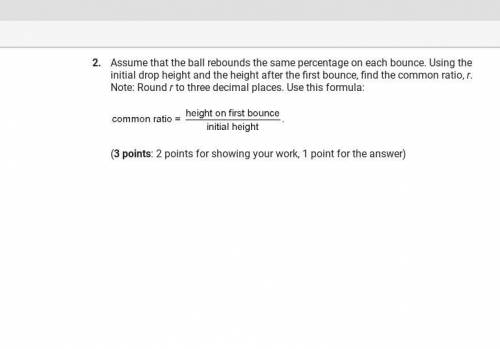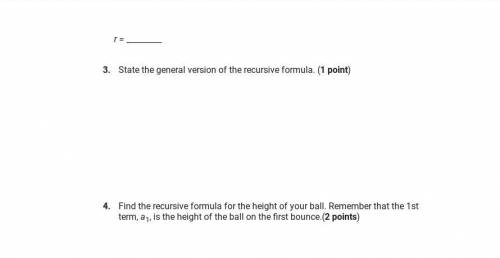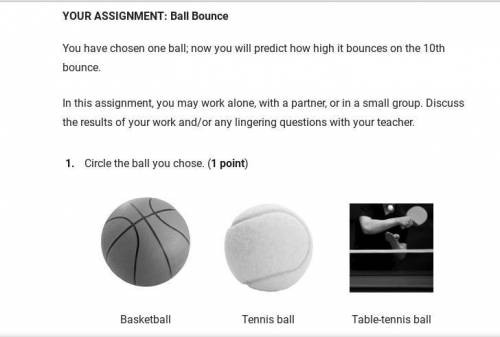7.2.4 practice modeling geometric sequences
Ball Bounce
You have chosen one ball; now you wil...

Mathematics, 02.02.2021 18:00, alexusray
7.2.4 practice modeling geometric sequences
Ball Bounce
You have chosen one ball; now you will predict how high it bounces on the 10th bounce.
In this assignment, you may work alone, with a partner, or in a small group. Discuss the results of your work and/or any lingering questions with your teacher.
1. Circle the ball you chose. (1 point)
Basketball Tennis ball Table-tennis ball
Writing an Equation
2. Assume that the ball rebounds the same percentage on each bounce. Using the initial drop height and the height after the first bounce, find the common ratio, r.
Note: Round r to three decimal places. Use this formula:
(3 points: 2 points for showing your work, 1 point for the answer)
r = _
3. State the general version of the recursive formula. (1 point)
4. Find the recursive formula for the height of your ball. Remember that the 1st term, a1, is the height of the ball on the first bounce.(2 points)
5. Fill out the following table for your ball's height after the first 3 bounces. Note: Let n = bounce number. The height on the 1st bounce, n = 1, is given. (2 points:)
Bounce n Height
First bounce 1 Basketball: 54 inches
Tennis ball: 58 inches
Table-tennis ball: 26 cm
Second bounce 2
Third bounce 3
6. Write the explicit formula for the geometric sequence of the height of the ball on the nth bounce. Use the formula an = a1 • rn – 1. Remember that the 1st term, a1, is the height of the ball on the first bounce. (2 points)
Solving the Problem
7. Using the explicit formula, find the height of the ball on the 10th bounce. (4 points: 2 points for showing your work, 2 points for the answer)
Taking Time to Reflect
8. What are some factors that could affect the ball's bounce? Why might a ball bounce higher or lower than the regulated height? (1 point)
9. For the sport you chose, why would it matter if a player used a ball that bounced higher than the regulation? (1 point)






Answers: 1
Other questions on the subject: Mathematics

Mathematics, 21.06.2019 17:30, meganenaranjo
If the speed of an electromagnetic wave is 100,000 cm/s and its wavelength is 100 cm, what is its frequency? a) 100,000 cycles per second (hz) b) 1 × 10-3 cycles per second (hz) c) 10,000,000 cycles per second (hz) d) 1,000 cycles per second (hz)
Answers: 1


Mathematics, 21.06.2019 20:30, allimaycatp8qgaq
Secant ac and bd intersect at point e inside f what is the measure of aed if measurements cd equals 30 a b is 50 and cb is 170
Answers: 1

Mathematics, 21.06.2019 22:30, badpotterchris
60 musicians applied for a job at a music school. 14 of the musicians play both guitar and drums. what is the probability that the applicant who gets the job plays drums or guitar?
Answers: 1
Do you know the correct answer?
Questions in other subjects:

Mathematics, 25.01.2020 12:31

Biology, 25.01.2020 12:31



History, 25.01.2020 12:31

English, 25.01.2020 12:31









